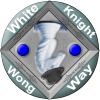Here's what I've learnt on the matter:
The chart that is frequently tossed around is derived from the 20/20 acuity chart. I believe it's called the Snellen chart.
In that chart... once you stop been able to define letters and numbers from each other with any reasonable accuracy, it's considered beyond the limit of your acuity.
For 20/20 vision, the limit of your acuity for the Snellen chart is roughly around 1 arcminute. Which is 1/60th of 1 degree on your field of vision. Of course as the place you're looking at deviates from your fovea (the center of your vision), the blurrier it gets. But we only count the sharpest part of your focus.
So it seems pretty reasonable to extrapolate that information about how much detail we can see from such a test.
Except there are a couple problems with doing this - the Snellen chart tests for rough shape recognition.
The character 'I' will look the same as the character 'l', or the number '1' at the limits of your acuity. Similarly M will look like W. And H will also look like M. But you won't mistake an M for an I.
So this means that even when we're hitting the limits of the Snellen acuity - we can still percieve additional information, albeit at reduced accuracy/increased fuzziness.
It turns out that the real limits of visual acuity (where we can't tell one element from another completely different element) is around the 0.15 arcminute mark. 1/6th of the Snellen acuity.
Having said this - in practical and useful terms, assuming that you sit from your screen such that it occupies a 35 degree FOV on your retina (the recommended distance - and the one that corresponds with 'the chart') - then the only areas where 4k will provide any benefit (and even then it'll be quite marginal) - is in areas of fine detail high contrast... such as hair shimmering in the light... or lines, or fine print in the distance.
For the most part, the extra resolution will not matter - other image quality factors including but not limited to contrast ratio, crushing/no crushing, frame rate, etc are more important to percieved quality.
On the other hand... if you want to sit closer... then the higher resolution will benefit you. But the problem with sitting too close is that film and video is framed under a set of natural assumptions - that the scene occupies a 35-45 degree fov on your retina max.
Taking the idea of sitting too close to an extreme - if you have to crane your head in order to see the corners of the screen where information like game huds typically lie, then it's too big.
As for film been a higher resolution - you can extract more information from a film than can be percieved - been that film is an analogue material with a cell like structure, you can keep going in - but past a certain point, all you're going to get is more pixels that make up a blob that make up a blur that make up part of an image that makes up an image. Going by a lot of remastered older film releases - modern 1080p digital filming offers significantly more perceived information than 4k transfers of older films.






